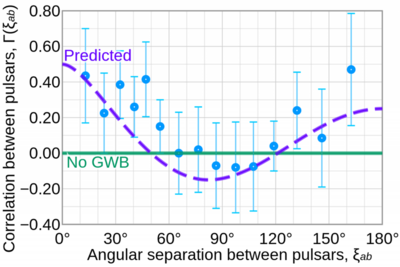
Chiara Mingarellli, assistant professor of physics, recently published a new popular science article on black hole mergers for Pioneer Works. This was her second piece of the Public Voices Fellowship, part of the OpEd project.
Astrophysicist Chiara Mingarelli on the noise of black holes merging, recorded in a single curve:
 On June 29, 2023, I gathered alongside my colleagues at the National Science Foundation’s Headquarters to announce evidence for an astronomical signal likely originating from millions of supermassive black holes simultaneously merging. If we could hear it, the signal—known as a gravitational wave background—might sound like a low-frequency hum, generated by the cosmic population of these supermassive black hole mergers. My colleagues and I found this signal by monitoring galactic pulsars—dense cores of dead stars—which send regular flashes of radio waves to the Earth.
On June 29, 2023, I gathered alongside my colleagues at the National Science Foundation’s Headquarters to announce evidence for an astronomical signal likely originating from millions of supermassive black holes simultaneously merging. If we could hear it, the signal—known as a gravitational wave background—might sound like a low-frequency hum, generated by the cosmic population of these supermassive black hole mergers. My colleagues and I found this signal by monitoring galactic pulsars—dense cores of dead stars—which send regular flashes of radio waves to the Earth.
The gravitational wave background’s hum also leaves a distinct imprint in pulsars. The waves change the distance between these pulsars and the Earth, causing their lighthouse flashes to arrive a little earlier or later as the spacetime is stretched and squeezed. I study supermassive black hole mergers as part of a team known as NANOGrav, which has data providing evidence of this gravitational wave background. The chances of the signal being random are about 0.3%. For a definitive detection, as accepted by most of the scientific community, this should be 0.00006%. We expect to make a detection at this level in the next few years.
Our discovery, that supermassive black holes merge, changed everything. For the last 40 years, leaders in the field met and openly debated the question. I have been working on experiments like NANOGrav for almost 15 years, while others have been working in the field for over 20 years. Now, for the first time, we have compelling evidence that supermassive black holes—millions to billions of times the mass of the sun—merge to create even more gargantuan black holes. This means that the simplest assumptions about how a pair of supermassive black holes evolve as they sink to the bottom of a new galaxy—and stall in their evolution—are wrong. We now know that gas and stars help these massive black holes merge, and that they form part of an astronomical ecosystem at the center of galaxies, where the black holes slingshot out stars to get closer together, and twist and turn as vast quantities of hot gas push them closer together. It is, in fact, big news that these supermassive black holes merge at all. This discovery shows that our models of how the universe works pass another test: the current paradigm is that galaxies form in the early universe and grow through mergers, getting larger with each merger. Each galaxy has a central supermassive black hole, so galaxy mergers should lead to supermassive black hole mergers. We now have evidence that this final step happens too—that the supermassive black holes merge. Before our NANOGrav result, we only knew that black holes about 30 times the mass of the sun merged. It took a whole new experiment, NANOGrav, and 15 years of data to show that supermassive black holes merge too.
Now, for the first time, we have compelling evidence that supermassive black holes—millions to billions of times the mass of the sun—merge to create even more gargantuan black holes.”
If I could time travel and tell my younger self that this was the case, I’m not sure I would have believed the good news. Reflecting back, I remember how amazed I was when I learned that gravitational waves had nothing to do with light. I had mistakenly imagined that beyond the known spectrum of light, past optical light, past the infrared, I would eventually find gravitational waves somewhere after radio waves. But, in fact, gravitational waves are not light. They are waves in the fabric of spacetime. All gravitational waves change the distances between objects, stretching and squeezing this fabric of spacetime as if it were lycra, pulling objects closer together and then further apart in predictable patterns. In the same way that different kinds of light require different tools for measurement, we need different telescopes to detect different gravitational wavelengths. NANOGrav and its precisely timed pulsars are needed to search for the low-frequency hum of gravitational waves with wavelengths that are light-years long.
In 1983, physicists Ron Hellings and George Downs published a seminal paper noting that the incoming signals from pulsars should be advanced or delayed by gravitational waves as they stretch and squeeze the distance between the Earth and the pulsars. The graph above is known as the Hellings and Downs curve. You don’t need to be fluent in data analysis to get a sense of its content. The curve encapsulates a prediction: A pair of pulsars that are close together, hence have a small angle on the sky (left hand side of the figure) are bobbing back and forth in the gravitational wave sea together, in sync. Ones that are further apart, at around 90 degrees, are out of sync.
When I first read the paper, I wondered if we would ever measure it. Also… why did it matter? What assumptions were baked in, and how did they write down the final equation? To answer these questions, we need to go back 40 years to NASA’s Jet Propulsion Laboratory. Hellings and Downs expected that the deviation in the pulsar’s timing would be so small (about 100 nanoseconds in a decade) that they had to be very clever about how to measure these tiny differences. What they discovered was that by cross-correlating pulsar data streams, anything common to both data streams gets amplified. The weaker the signal, the more pulsar data streams are needed to sufficiently amplify the signal and make it detectable. The more cross-correlations, the more amplified the signal.
The Hellings and Downs detection strategy introduced a new way of understanding whether or not the signal we would eventually measure originates from gravitational waves, which would result in making the Hellings and Downs pattern after cross-correlation. Nothing else in nature that we know of can create the distinctive Hellings and Downs correlation pattern between pairs of pulsars.
Fast forward about 30 years, to 2014. When I was a Marie Curie Fellow at the California Institute of Technology (Caltech), and a visiting scientist at NASA’s Jet Propulsion Laboratory, some of the most famous scientists I knew told me that maybe one day NANOGrav would measure just one number—the amplitude of the gravitational wave background—if we were lucky. But it was unlikely, since everyone knew that supermassive black holes don’t merge. They advised me to work on another experiment, LIGO, that detects gravitational waves from drastically smaller black holes. My chances of having a career were much better if I developed the gravitational-wave theory for LIGO instead of NANOGrav. It was good advice: LIGO was a juggernaut with an almost $2 billion investment from the National Science Foundation, and there was a very large group at Caltech dedicated to its development. NANOGrav had just secured its first $15 million grant, over five years, to support its 100 scientists. That is to say, still a very small experimental budget. But I couldn’t give up on pulsar timing arrays. Hellings and Downs assumed that the gravitational wave background was arriving equally from all directions in space, but I was not convinced. Surely, I thought, some parts of the sky could have a nearby pair of supermassive black holes, or that clusters of them could exist, and then what happens to the curve?
It was as if they were all chanting “Om” together at the end of their galaxy merger process, incredibly thrilling—as if everything finally came together to make this gravitational wave sound.”
This brings us back to June of last year, at the National Science Foundation Headquarters. After timing an array of pulsars every two weeks for 15 years with some of the best telescopes on the planet, we finally saw the Hellings and Downs curve emerge in the cross-correlated NANOGrav data (the blue points in the figure). When I saw the curve emerging and could see with my own eyes that the curve was really there, I was filled with disbelief and excitement. The blue dots and their error bars were finally overlapping with the purple line, which is the Hellings and Downs curve. There before us was evidence that supermassive black holes merge, and not just a few, but the cosmic population of supermassive black holes humming in unison. It was as if they were all chanting “Om” together at the end of their galaxy merger process, incredibly thrilling—as if everything finally came together to make this gravitational wave sound.
NANOGrav showed that the Hellings and Downs curve exists, but what I was able to show was that this should just be the first smooth layer of the gravitational wave background—a layer which many presumed did not exist. I predicted that there are many layers we can measure, and, in fact, we could measure more than just these maps. We could probe different models of the early universe, test Einstein’s Theory of General Relativity, explore and probe exotic forms of dark matter, and more. Now many teams are searching for the subtler layers in the background and we are hoping to eventually make maps of the entire sky of gravitational waves. It’s an exciting time. Many colleagues have now shown interest in making these gravitational wave background maps, and a whole new subfield of astrophysics related to finding and measuring these layers of the gravitational wave background is thriving.
We may soon be able to make these maps, and to locate the closest or most massive supermassive black hole pairs. Finding these pairs would be irrefutable evidence that supermassive black holes merge, and that our current theories of how galaxies form and evolve, through mergers, hold. We will be able to constrain exotic theories of dark matter, theories of the early universe, and be on the lookout for new, unexpected humming signals which we haven’t yet predicted or anticipated. What else is out there? I have no idea. That’s what’s so exciting.♦
This article was adapted from the Pioneer Works article of May 22, 2024 by Chiara Mingarelli. Please see below for the link to the original article.